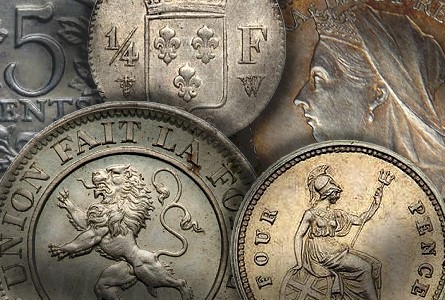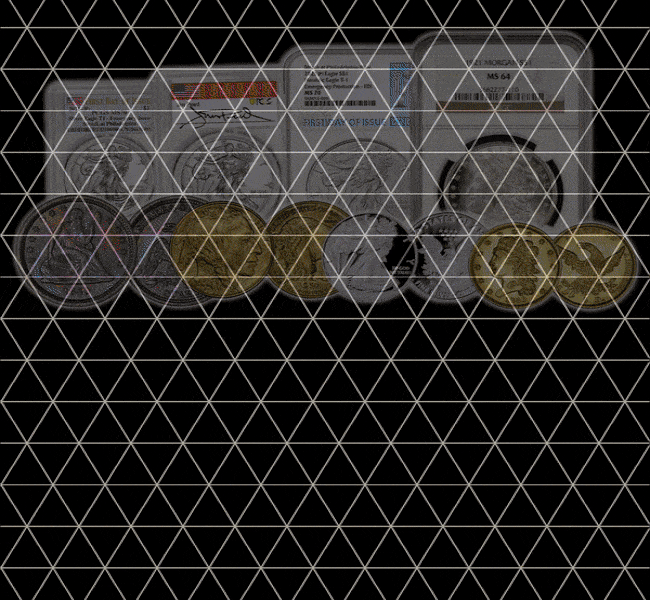By Al Doyle for CoinWeek …..
Accumulating silver bullion is a satisfying task, but there’s much more to the metal than sheer ounces. Coins are full of art and history, and those elements often lead to collecting. When examining the whole spectrum of silver, it’s natural to wonder why dozens of nations have issued small world silver coins – sometimes less than half the weight – of a pre-1965 U.S. silver dime. Who would want something so dinky and easily misplaced or lost?
The intrinsic – or metallic – value of coins was the most important factor for many people into the 20th century. That’s why U.S. large cents were minted until 1857. If it came to choosing between a button-sized disk of silver or a larger base metal piece, precious metal often won out over ease of use.
 Attempting to cover all the dinky silver pieces of the world is quite a task, so the focus here is on European coinage. Quite a few billon (low purity) pieces circulated in the central part of the continent, but modern collectors prefer coins where silver makes up the majority of the planchet. British Maundy sets and singles from this historic series are an ideal place to begin a collection of flyweight silver.
Attempting to cover all the dinky silver pieces of the world is quite a task, so the focus here is on European coinage. Quite a few billon (low purity) pieces circulated in the central part of the continent, but modern collectors prefer coins where silver makes up the majority of the planchet. British Maundy sets and singles from this historic series are an ideal place to begin a collection of flyweight silver.
Issued annually for distribution to elderly British citizens, Maundy sets contain 1, 2, 3 and 4-pence pieces in .925 fine (sterling) silver. At .0140 ounce of the metal, it would take 72 silver pennies to accumulate a full ounce of silver. With .0280 ounce of silver, the 2-pence would have to grow to contain a gram of the metal.
Sterling 3-pence pieces were a part of circulating British coinage until 1920 when the composition was debased to .500 fine. The old version holds .0420 ounce of silver, while the .500 fine examples contain .0227 ounce. In addition to Maundy sets and singles from broken sets, numismatists could build a long-running collection of circulation strikes as well as silver 3 pences from other nations such as Australia, New Zealand and South Africa.
Also known as the groat, the 4 pence was struck for circulation until 1855. It weighs in at a relatively stout .0560 ounce of silver, which means it takes 18 pieces to accumulate an ounce of precious metal. The silver 1 1/2 pence was struck for usage in Ceylon (now Sri Lanka) and Jamaica from 1834 to 1870.
The collector who wants to go all out on dinky silver will find plenty of options with pre-1850 French coinage. The 1/4 franc was struck on a .900 fine planchet containing .0362 ounce of the metal. Struck from the Napoleonic year of AN 12 (1803) to 1848 (and designated as the 25 centimes from 1845 to the end of the series), this batch of coinage includes numerous low-mintage issues struck by French regional mints.
If the AN12M 1/4 franc and its mintage of 39,000 sounds attractive, it gets much better than that. Check out the AN12M (16,000), AN12H (12,000), AN12A (19,000), AN13U (14,000), 1806L (18,000), 1807U (13,000), 1807A (17,000), 1819A (11,000), 1820A (12,000), 1826L (11,000), 1828Q (13,000),1833K (22,000) and 1833T (18,000) for low-mintage dates at reasonable prices.
Maybe those 1/4 franc pieces aren’t challenging enough. If that’s the case, try and locate dates such as the AN12D with a mintage of 5,156. Keep going on the four-figure mintage track with the AN13H (2,744), AN12K (8,122), AN14K (1,757), AN13BB (2,194), AN13MA (8,114), AN14U (100), 1806I (4,583), 1807I (8,356), 1806K (4,359), 1807K (5,538), 1807L (7,618), 1806Q (8,943), 1807Q (9,713), 1806U (1,361), 1807M (1,626), 1808I (1,466), 1836K (9,500), 1831L (6,182), 1833L (8,927), 1834L (8,789), 1831M (6,831), 1833 MA (3,452 and rarer than that number suggests) and the 1832T (8,486).
A number of other miniature silver coins were issued for circulation in Europe during the 1800s and 1900s. The Netherlands 5-cent piece (speck?) was struck from 1848 to 1887. The .640 fine planchet includes .0141 ounce of silver, which means 70 pieces wouldn’t equal a full ounce. The 10-cent piece of the same fineness held .0288 ounce of the metal and was struck for usage in Holland until 1945 and for overseas territories until 1970. All three U.S. Mint facilities struck the 1944 and 1945-dated 10-centers.
Belgium’s 20 centimes had a brief run from 1852 until 1858. The .900 fine piece weighed in with .0289 ounce of silver. The 1869 Spanish 20 centimos has “collector coin” written all over it, as the mintage of 91 indicates. Plan on spending a low four-figure price for this rarity in circulated grades. The coin has roughly 60 cents worth of silver (.0268 ounce) in a .835 fine alloy. An additional 5,000 were produced in 1870. Neighboring Portugal struck the 50 reis on an irregular basis from 1855 to 1889. It contains .0369 ounce of silver on a .917 planchet, and the more common dates sell for well under $10 in Very Fine and Extra Fine.
If crowns and silver dollars are your idea of heavy metal, check out Europe’s smallest circulating silver pieces. These Chihuahuas of the numismatic world can be quite appealing, and they are available at every price point on the scale.





Great article, Al! I’m more of a big, hefty crown guy myself, but I’ll have to check out some of these mini coins.